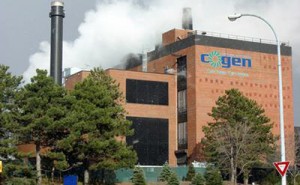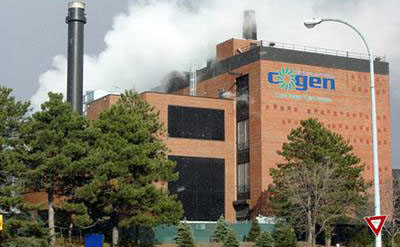
Nestled in between Elmwood Avenue and Intercampus Drive lies University of Rochester’s Central Utilities plant, recognizable by the billows of steam often seen emanating from its vents. The plant is a powerhouse tasked with providing steam, chilled water, hot water and electricity to the River Campus and Medical Center. The facility is home to several large-scale operations that aid in this endeavor, including a chilled water plant with a capacity of 21,000 tons, and large steam turbines which can generate electricity up to 25 megawatts—enough to power the needs of 25,000 average households.
In the case of the Central Utilities plant, its great power comes with great responsibility. This is exemplified by a recent overhaul of “Chiller # 3”, one of the five water chillers at the plant, in order to eliminate its reliance on a previously popular, yet environmentally unfriendly refrigerant gas known as “R-12”.
Chemically, R-12 is classified as a chlorofluorocarbon (CFC). Every pound of R-12 released into the atmosphere has the equivalent global warming potential of about 10,000 pounds of carbon dioxide. It is considered to contribute greatly to the depletion of the ozone layer of the Earth’s atmosphere. The ozone layer is responsible for resisting ultraviolet radiation, a known cause of multiple diseases, including skin cancer. For these reasons, an international treaty called the Montreal Protocol called for regulation on pollutants like R-12, and therefore it is now no longer in active production.
Although it is unlawful to willingly emit R-12 to the atmosphere, R-12 may be accidently released to the atmosphere. Despite the elimination of its production, R-12 is still used in many old refrigeration facilities. As there is no longer a supply of R-12 being produced, the price for current inventories of R-12 has increased due to its scarcity. This provides an incentive for current R-12 owners looking to phase out of using the gas, to opt into selling it to the reclaim market, thereby continuing its use.
Inspired by the university’s record of reducing an average of 95 metric tons of CO2emissions annually, Central Utilities, led by Steve Mischissin, sought a better way to dispose of the R-12 previously used in “Chiller #3”. This led to a six-month-long three-way collaboration between the U of R, EOS Climate, and Carrier Corporation dubbed the “Chiller Modernization Project”.

The project began in November of 2011, and consisted of two major phases. In the first phase, EOS Climate, a company specializing in the environmental safe disposal of CFC refrigerants, removed over 12,500 pounds of R-12 from the designated water chiller, and safely destroyed it. According to Mr. Mischissin, had the R-12 from the single chiller been accidently released to the atmosphere, this alone would be the global warming equivalent of 56,000 metric tons of carbon dioxide, comparable to the carbon footprint of 2,800 Americans over the course of an entire year.
The price tag on EOS Climate’s services may come as a bit of a surprise to many. In fact, overall, the project resulted in the University receiving over $235,000 for the transaction. This may leave many feeling puzzled. What incentive does EOS Climate have to not only safely destroy this gas, but also pay for the opportunity? The answer lies at the heart of an emerging industry that rewards environmentally responsible behavior to all parties involved in reducing greenhouse gases. The increasingly robust market in question is none other than the carbon emissions trading industry.
While the United States has no nation-wide cap on the emissions of greenhouse gases, the Regional Greenhouse Gas Initiative (RGGI) has implemented a legal limit on the amount of carbon dioxide power plants can currently emit in nine states in the northeast region of the country. This initiative represents the first mandatory carbon emissions cap anywhere in the United States. The initiative allows for power plants to purchase “carbon credits” in order to increase their current “allowance” of carbon dioxide emissions. Power plants that are responsible and emit very little carbon dioxide emissions can sell their remaining allowance in the form of carbon credits. Further, companies that make active efforts to reduce greenhouse gases may also earn carbon credits which they may choose to sell to other industries.
This system is often referred to as a “Cap and Trade” system, and is a popular approach to helping promote environmentally responsible behaviors from organizations that produce carbon emissions. This approach is gaining momentum fast, with California planning to implement a comprehensive Cap and Trade system within its borders towards the end of 2012, and with the EPA announcing its plans to implement a full nationwide cap on carbon emissions from power plants. Companies like EOS Climate have taken advantage of this momentum by getting a head start in the industry. They look to earn carbon credits by preventing the emission of greenhouse gases like R-12, and are in a position to sell these credits to other firms seeking to increase their emissions allowance. Institutions like the Climate Action Reserve track and verify carbon emissions reductions taking place around the country, utilizing agreed upon systems such as the “Voluntary Carbon Standard” to calculate how to reward carbon credits.
When EOS destroyed the University’s R-12, it was able to earn carbon credits as per the Voluntary Carbon Standard, and in turn the University received a payment of over $235,000. These carbon credits could potentially accrue a higher value over time as the carbon emissions trading industry grows. According to Matt Jones, CEO of EOS Climate, “This project represents a real win for all of us – for the students, and most of all, for the environment.”
In addition to this revenue, the University also earned over $77,000 for having recycled around 38,000 pounds of old copper tubing from their water chiller during the second phase of the project, adding to the already impressive programs the University has of managing recyclables. With the help of Carrier, a supplier of refrigeration products and services, a retrofitted water chiller has been set into place. According to Mr. Mischissin, the upgraded Chiller # 3 and its steam turbine drive is not only 5% more efficient than the old one, but also uses modern refrigerant called R-134A which causes zero ozone depletion, and has nearly seven times less global warming potential than R-12.
The Chiller Modernization Project is a great representative of the University’s commitment to Go Green, demonstrating how small choices, such as the replacement of a single water chiller, can have ripple effects in the ongoing effort to promote environmentally sustainability. With the successful overhaul of Chiller #3, Mr. Mischissin and Central Utilities are eagerly anticipating future modernization projects at the facility.
Looking back at the successful installation of their retrofiited water chiller, which is both environmentally friendly and more efficient in its operation, it appears that at Central Utilities, with great environmental responsibility, also comes great power.


Good blog you’ve got here.. It’s difficult to find excellent writing like
yours nowadays. I truly appreciate people like you! Take care!!
Unichillers are intelligent chillers which can be used as an environmentally friendly and economic alternative to tap water for process cooling. Low temperatures increase efficiency and recovery rates in gas condensation processes. br>
Cryostats
The chillers come with sophisticated technology that offers efficient service at a very affordable price. It has a tube heat exchanger that can offer cooling very quickly and that too without making in a lot of noise. It is not very heavy and does not consume a lot of space. Since the oil feeding system of the chillers does not require any kind of electrical mechanism, the life of the compressor is increased.
Process Temperature Control, Process Temperature Control manufacturers and suppliers in India. Huber India is the best manufacturering and suppling company for Process Temperature Control.br>
For more details please visit http://www.huber-india.net/chillers.php
Excellent article. Excellent work Mr. Mischissin.